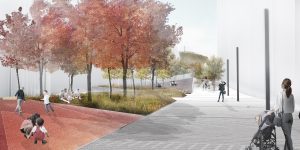By Audrey Girard
The reason why we have cities today is the same as it was centuries ago – to bring people together. However, in the pursuit of generous private spaces and the rise of the vehicle, we’ve lost some of the elements that make urban living great. With over 75% of the world’s population expected to reside in cities over the next 30 years, investing in the urban form – particularly in adapting the urban form of our Northern cities – is more important than ever. So what does a well-designed Northern city of the future look like?
In order to increase liveability in both what we will build and in what we already have built, all cities need to consider important climate-resilient paradigms for the urban form and comfort, especially in northern countries like Canada. At the same time, the Canadian urban form should embrace and reflect our behaviours, desires and needs throughout all four seasons.
As an urban designer, I believe it’s important to create generous and quality spaces for people to grow and thrive in their own urban context. Urban design needs to be catalyst for positive change, towards cities that are liveable all year long.
The urban form’s role in liveability
Starting with a baseline, the urban form is defined in essence by the relationship between the street network, open and green spaces, and the built environment. The scale, nature, and rhythm of these three elements at play compose any given urban form, and their combinations are practically infinite.
When we talk about liveability in the urban form, we’re talking about the equitable, physical and mental wellbeing of the people who live in cities. The urban form can support liveability which in turn affects the everyday lives of those who live there, determining things like why and how far we travel and the space we occupy. It is also narrating a story, a history shared by inhabitants and forged over time through its materials and technologies, that translates the cities’ key social and individual aspirations.

Liveability through seasonal extremes
Designing for Northern cities demands that we, as urban designers, address extreme temperature fluctuations through climate-resilient urban design. How can design encourage people to reconnect with the outdoors, without jumping into their cars during colder months? Urban comfort, supported by great design, looks very different in the winter than the summer; how can the same space be useable in both plus 30 and minus 30-degree weather?
Through harsh winters, encouraging people to go outside and engage with the city during colder months can be incredibly challenging, but adaptive urban planning and design can be pivotal in addressing various elements including the cold, wind, light and materiality to make spending time outdoors during winter months more enjoyable:
- Designing winterized public realms. These spaces allow light and sun light at pedestrian scale, sidewalks with trees to cut wind, space for snowbanks, minimizing wind turbulences and corridors with proper setbacks and alignments.
- Warmth and light. Providing warming hubs, enclosed shelters, wind shields and fire pits across the city in public spaces not only allows urban dwellers to warm up, but also provide a source of heat to our houseless neighbors and light up dark snowy nights.
- Space and trail networks for winter physical activity. Green spaces can be connected via intricate networks of white trials and biodiverse corridors, that can facilitate cross-country skiing or snowshoe trails, along with building skating rinks to encourage outdoor activity through snowy and icy months.
- Diversifying forms. A diversity of uses for spaces near outdoor destinations such as cafes, libraries, and arenas can ensure there are public places to warm up.
- The use of wood and a warmer color spectrum to cultivate a sense of warmth and coziness.
- Accessible underground networks. Placing importance on creating and supporting underground networks whether for walking or public transportation to travel around the city with ease, regardless of weather conditions.
Meanwhile, the summer months pose an entirely different challenge to our cities’ urban forms and expressions, where design can help in mitigating high temperatures and provide spaces to enjoy the outdoors on hot days. This challenge has become increasingly relevant with climate change driving temperatures higher over the past decade. Creating well-designed outdoor urban space is especially important during the hot summer months where certain city dwellers may not have access to air conditioning or bodies of water to cool off. Here are a few key design ideas that can help foster more liveable cities during warmer months:
- Provide more shade. This can be done with greenery like trees or built structures like canopies and temperate shelters. Shade is critical for human comfort outdoors in warmer months.
- Porosity of blocks and grids. Encourage natural ventilation of courtyards and streets.
- Articulated ground floors. Designing to a human scale and ensuring that the ground level of a building offers rest areas and protection.
- Lightening color of surfaces. Changing the color of various design elements like benches, walkways, and roads can help in decreasing the heat absorption of dark surfaces.
- More water. Adding urban water features can help urban residents cool off, like sprinklers, splash pads and fountains.
Great design can start now
Canadian winters and summers present their own respective design challenges that need to be addressed through one overarching design approach, and prioritizing climate-resilient urban designs will allow us to create more liveable cities.
Urban centres are in a constant state of evolution and building upon themselves. We need to contemplate past mistakes and have the courage to reshape our urban centres to respond to future needs through a climate-resilient approach. By embracing and celebrating the qualities of our cities through a sensible lens while staying open to rethinking current elements, we can envision better cities for future generations – that includes making our northern cities liveable and enjoyable throughout all four seasons.
Dive deeper into how we can make the most of our need for better cities by reading about how we can design places that last.
 As a pioneer in her field, Audrey seeks to integrate sustainable development principals and heritage enhancements into development projects in a simple, efficient and creative manner, combining sensitivity and innovation. She leads the planning and design of large-scale projects and is responsible for major development projects for institutional, private and municipal clients. She excels at designing innovative and sustainable living environments and landscapes, realizing master plans for landmark developments, and guiding architects, developers and public institutions through the design and approval processes for sensitive urban projects. Specialized in environmental design and landscape environments, Audrey brings a multi-scalar and transdisciplinary approach to her work, fueled by a keen understanding of the context and an in-depth knowledge of the most recent trends in planning worldwide.
As a pioneer in her field, Audrey seeks to integrate sustainable development principals and heritage enhancements into development projects in a simple, efficient and creative manner, combining sensitivity and innovation. She leads the planning and design of large-scale projects and is responsible for major development projects for institutional, private and municipal clients. She excels at designing innovative and sustainable living environments and landscapes, realizing master plans for landmark developments, and guiding architects, developers and public institutions through the design and approval processes for sensitive urban projects. Specialized in environmental design and landscape environments, Audrey brings a multi-scalar and transdisciplinary approach to her work, fueled by a keen understanding of the context and an in-depth knowledge of the most recent trends in planning worldwide.

 As a pioneer in her field, Audrey seeks to integrate sustainable development principals and heritage enhancements into development projects in a simple, efficient and creative manner, combining sensitivity and innovation. She leads the planning and design of large-scale projects and is responsible for major development projects for institutional, private and municipal clients. She excels at designing innovative and sustainable living environments and landscapes, realizing master plans for landmark developments, and guiding architects, developers and public institutions through the design and approval processes for sensitive urban projects. Specialized in environmental design and landscape environments, Audrey brings a multi-scalar and transdisciplinary approach to her work, fueled by a keen understanding of the context and an in-depth knowledge of the most recent trends in planning worldwide.
As a pioneer in her field, Audrey seeks to integrate sustainable development principals and heritage enhancements into development projects in a simple, efficient and creative manner, combining sensitivity and innovation. She leads the planning and design of large-scale projects and is responsible for major development projects for institutional, private and municipal clients. She excels at designing innovative and sustainable living environments and landscapes, realizing master plans for landmark developments, and guiding architects, developers and public institutions through the design and approval processes for sensitive urban projects. Specialized in environmental design and landscape environments, Audrey brings a multi-scalar and transdisciplinary approach to her work, fueled by a keen understanding of the context and an in-depth knowledge of the most recent trends in planning worldwide.